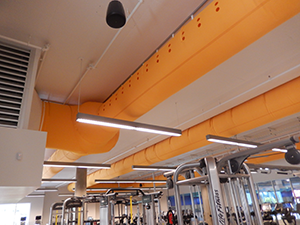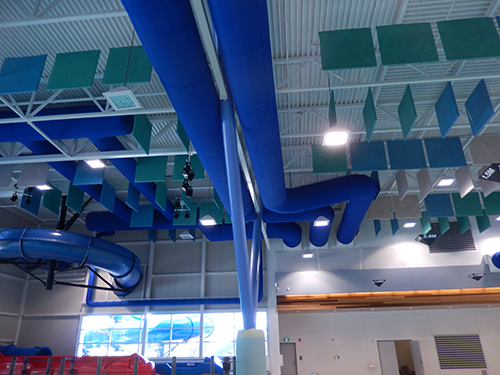By Norm Grusnick, PEng • ECCO Supply

Architects and engineers are constantly seeking innovative and efficient solutions for their projects. In the world of HVAC systems, there’s an alternative solution you might not have considered: fabric air dispersion systems. These systems offer a host of benefits from enhanced air distribution to ease of installation, making them a compelling choice over traditional ductwork.
Before we dive into the design process, let’s take a moment to understand why fabric ducts are gaining popularity in industrial architecture. Fabric ducts excel at delivering consistent and draft free airflow. They distribute air evenly throughout the occupied space, eliminating hot and cold spots, which can be a challenge.
Fabric ducting offers a sleek and unobtrusive aesthetic, blending seamlessly with modern designs. The trend toward open architectural ceiling design versus T-bar-style ceilings is boosting fabric duct as a ventilation choice. Open ceilings are a perfect application for fabric duct, whereas recessed ventilation duct must be metal, according to most codes.
Fabric duct is remarkably easy to install, resulting in reduced labour costs and project timelines. The system typically arrives on the jobsite in two to three weeks and can be installed four times faster than conventional ductwork. Fabric ducting’s lighter weight reduces lift equipment rental costs. Lighter ductwork also reduces the number of workers required to install it, which is an advantage considering today’s lower staffing levels.


Above: Fabric duct at Langford Aquatic Centre in Langford, BC.
For example, a 48-inch metal spiral duct hung from a 25-foot-high ceiling may need several heavy-duty lifts and three or four workers to rig it into position. However, the same sized fabric duct might require a lighter duty, less expensive lift rental and only two installers to hang it. Using fabric ducts can also save up to 40% on the cost to run a ventilation system as they are designed to provide uniform air dispersion through a combination of air-porous fabrics, linear vents, nozzles, and orifices. This method has a positive impact on energy costs as these systems heat and cool spaces faster and more uniformly to satisfy temperature set points. The result is reduced mechanical equipment run time.
There are a few things you’ll need to collect before incorporating fabric ducts into your project to meet its unique requirements. Here are key points for your design:
- Determine the CFM required for your space to meet your needs and select the right air handling unit.
- Formulate the duct layout for an efficient and cost-effective solution.
- Consider the layout of the space, including occupancy pattern and obstacles. This will help you identify optimal air dispersion locations, the type of hardware required, and other critical design elements.
- The mounting height of the ducts influences the type of airflow model needed for the space. Different mounting options, such as overhead or perimeter, cater to your system needs.
- The purpose of the space plays a significant role in fabric and dispersion type selections. The fabric ducts should align with the specific indoor air quality requirements.
Both metal and fabric duct have a place in the construction industry. Architects, specifiers, and design/build contractors should examine every project scope for the best choice. ■



